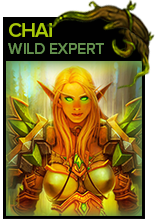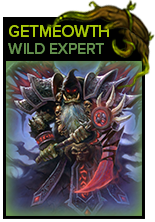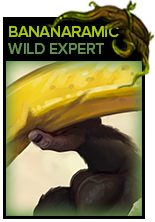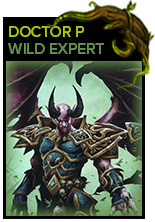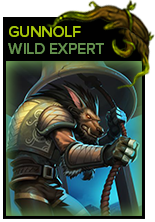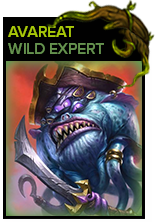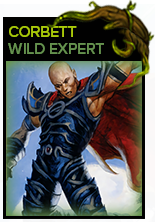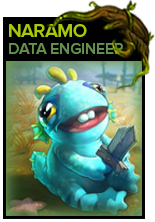
Welcome back to the Wild vS Data Reaper Report! We’re the experts from r/WildHearthstone, and we have partnered with Vicious Syndicate to create the Wild Data Reaper Report. We will be contributing the write-ups and analysis for the report, backed up by the statistics that Vicious Syndicate has become famous for. The data presented in this article is based on 35,000 games.
With the 2nd report for Saviors of Uldum, we can look at how the meta has changed over the past few weeks. While we haven’t seen any major shifts of currently existing archetypes, which may only be dethroned by either a new expansion or balance changes, there are signs of an emerging deck that could prove to be game changing for the format, which we will talk about later.
In order to ensure that we can provide updated reports as quickly as possible, we encourage you to register to contribute your data to the Vicious Syndicate project in order to compile more comprehensive reports. Signing up is quick, easy and your contributions are extremely important, and much appreciated!
Quick Links
Class/Archetype Distribution | Matchup Winrates | vS Power Rankings | Meta Score | Class Analysis & Decklists | How to Contribute | Credits
Class/Archetype Distribution
[TABS_PRO id=29936]
Much like in the previous report, the Wild Hearthstone ladder exhibits two drastically different metagames. One represents the field when climbing ladder, while the other represents the field once you cross the threshold into legend.
Mage is the most popular class outside of legend, reaching over 25% of the field at ranks 4-1. Aluneth Mage represents 18% of opponents in this rank bracket and is the most popular deck in the format overall, yet it does noticeably drop off at legend. Reno Mage is also common throughout ladder, and becomes more popular at legend, where it nears Aluneth Mage’s 10% play rate. Quest Mage and Exodia Mage remain very fringe. Exodia Mage was touted to be a SN1P-SN4P Warlock counter, but its horrid performance against most other decks in the current meta has kept it out of sight.
Warlock remains a very popular class with a smattering of archetypes. It is the second most popular class outside of legend and rises to the #1 spot at legend. This can be attributed to the massive jump in play rate of SN1P-SN4P Warlock, which becomes the most popular deck at legend. At ranks 4-1, SN1P-SN4P and Reno are equally popular. At lower ranks, SN1P-SN4P is quite uncommon, and Reno Warlock is the most common opponent you run into. Other notable Warlock archetypes with lower play rates are Cube Warlock, Mecha’thun Warlock and Darkest-Hour Warlock.
Shaman is a very diverse class throughout ladder. Reno, Murloc, Even and Quest Shaman can be spotted at all rank brackets. As you reach the higher end of ladder, a relatively new deck in the format, Evolve Shaman, becomes more noticeable. It seems that the Desert Hare/Evolve combo, which has proven to be extremely oppressive after the temporary re-introduction of Evolve back into Standard, has inspired Wild players to try it out where it will be permanently available.
Mech Paladin has taken over its class and become the dominant archetype in Saviors of Uldum, while Odd Paladin continues to dwindle in its play rate. This might be caused by perception of power, or the fact that Mech Paladin is a newer, more exciting deck compared to the stale and unchanging Odd Paladin. As we’ve seen in the last report, both decks looked strong and could justify a place in the meta.
Big Priest maintains a high play rate at lower ranks. It is, quite astonishingly, the most popular deck in the game at the 14-10 rank bracket. This could support Blizzard’s claim that people simply enjoy playing the deck, regardless of its power level. Its play rate drastically declines as you climb ladder, and it looks very fringe at legend. Reno Priest sees modest play throughout ladder, while dragon decks have faded away due to the change in the discover mechanic. This might be a good time to have a dragon-themed expansion!
Odd Rogue seems to be the only relevant competitive option for Valeera, and its play rate has slightly increased, perhaps a result of its strong showing in the last report. The meme brotherhood of Mill and Thief Rogue is still around, of course.
Druid, Hunter, and Warrior are mostly ignored in the current meta. Jade Druid looks like the most stable deck present within its class. Hunter is composed of Mech Hunter and Reno Hunter. Warrior is the class that’s closest to extinction, with a little bit of Pirate Warrior, and an assortment of slow Warrior decks.
[TABS_PRO id=29937]
vS Meta Score
[TABS_PRO id=29938]

[TABS_PRO id=29940]
After its breakout performance in our last report, SN1P-SN4P Warlock is widely recognized these days as the poster deck of broken Wild synergies, and there’s a strong case supporting the claim that it is absolutely broken.
At legend, SN1P-SN4P is the strongest deck in the game and continues to exhibit a high skill cap that is reflected by its improvement of multiple matchups at higher levels of play. With incredible survivability and flexibility, SN1P-SN4P’s matchup spread is mind-blowing, as players have further refined and optimized its build and play. Not a single deck looks capable of beating it, and its worst matchup is the mirror. SN1P-SN4P Warlock looks truly unstoppable, and the only factor that seems to be stopping it from blowing up all across ladder is how difficult it is to play to its maximum potential.
Odd Rogue is the strongest deck in the game outside of legend, and only falls behind SN1P-SN4P Warlock at legend. It seems to have improved its Mage matchups compared to the last report (Rogue players are handling Mage secrets better while benefitting from Reno Mage’s erratic experimentation), leading to a matchup spread that’s nearly flawless. Looking at its play rate, it certainly looks extremely underrated. Only SN1P-SN4P Warlock has proven to be a consistent kryptonite for Rogue.
Aluneth Mage is showing remarkable resilience, taking into consideration that it is the most heavily targeted deck in the format due to its popularity. The presence of Eater of Secrets is massive, and yet Aluneth Mage continues to sit at Tier 1 throughout ladder. Its lowest point is exactly where it is most popular: ranks 4-1.
While Mech Paladin is a powerful deck, Odd Paladin’s win rate has shot back up over the past month in impressive fashion. Surprisingly, it looks like the slightly stronger deck. While Mech Paladin performs better against Mages, Odd Paladin is stronger against Shamans and carries a significant edge in the mirror, so it shouldn’t be overlooked. Much like in the case of Odd Rogue, players might be sleeping on the power of Baku.
Genn isn’t too bad either. Even Shaman sits around Tier 2. Its biggest weapon in the current meta is Devolve, as the card is very impactful in its dominant matchup against Mech Paladin. The issue with Devolve is that it isn’t as effective against SN1P-SN4P Warlock these days, due to the rise of Target Dummy, a card we’ve suggested should see more play in our last report. Target Dummy allows the Warlock to neutralize Devolve by having SN1P-SN4P magnetize the Devolve-immune 0-cost minion. With Dummy’s rise in prevalence, we’ve seen the matchup go progressively worse for the Shaman, which is why Even Shaman has grown weaker at legend.
Reno Mage’s performance has slipped over the last month, and it now sits firmly at Tier 2. Vast experimentation with Quest Reno builds is the primary culprit for the archetype’s decline in win rate, as we haven’t been impressed by this variant’s rise in popularity (N’Zoth is significantly stronger).
Reno Warlock still looks mediocre in the current meta. It has many close, winnable matchups, but it doesn’t perform exceptionally well against anything. It’s simply outclassed by SN1P-SN4P.
Hovering between Tier 3 and Tier 4, Murloc Shaman and Mech Hunter look barely competitive. Murloc Shaman’s horrid matchups into Aluneth Mage and Odd Rogue are massive issues, while Mech Hunter’s performance against the top meta decks isn’t very impressive either. Both decks tend to punish poorly optimized decks, so they have declined in their win rates due to the meta “cleaning up”.
Tier 4 has several Reno decks trying to emulate Mage and Warlock. Reno Hunter has failed to build on the promise it showed in the last report. Reno Shaman has vastly improved its performance thanks to refinement, but still doesn’t look too competitive. Reno Priest looks very weak and doesn’t exhibit any redeeming qualities.
Big Priest looks quite hopeless without its turn 4 Barnes, and sits deep in Tier 4. Quest Shaman hasn’t been able to replicate its Standard success in Wild, and Thief Rogue continues to meme away.
Finally, let’s talk about what might be the most interesting finding in this data set, which comes from our lower sample estimates. Usually, decks that aren’t common and present a low sample, will be decks that aren’t very good or find themselves overshadowed by a stronger alternative. However, in this case, we have a couple of decks that are very strong but haven’t caught on yet.
Cube Warlock’s new build incorporating Nerubian/Serpent Eggs, Evil Genius and Plague of Flames looks extremely promising. The more proactive early game gives it a much better chance now against aggressive decks, while it maintains its historically good matchups into slower decks. We estimate that it’s a Tier 1 deck at all levels of play and merits a lot more attention.
We did not put Evolve Shaman in “Tier 0” as a joke or because we’re interested in a sensational headline. We’re making a point that, should this deck rise in popularity and keep its win rate, it would clearly be the best deck in the game with only SN1P-SN4P Warlock providing competition for the top spot at legend. While it’s unfortunate that its win rate carries too high of a variance for us to place in the Power Rankings with confidence, the uncertainty isn’t about whether Evolve Shaman is a Tier 1 deck: it’s about the extent of this deck’s absurdity.
In fact, when we evaluate the archetype, we can only conclude that it’s not even close to being refined, which is why its current win rate is so alarming. In hindsight, it is mind-blowing to see how long it is taking players to find out that Desert Hare, Mogu Fleshshaper and Evolve are just as busted in Wild as they are in Standard, especially when Wild Evolve Shamans can add even more Evolve synergy and consistency to the mix. The only thing that’s left to do is get down to optimizing the archetype’s card choices, collecting more data, and then figuring out whether we have another SN1P-SN4P Warlock in our hands.
Class Analysis & Decklists
Druid | Hunter | Mage | Paladin | Priest | Rogue | Shaman | Warlock | Warrior
Druid is going through a slump in Wild. The fierce competition from other classes is proving to be too much for it to handle. It is currently one of the least popular classes in the game throughout ladder.
Jade Druid is the only Druid deck that makes it into this report in some capacity, and it’s also the only one that looks remotely competitive. It does so by placing in Tier 3 in the low sample estimates. Jade Druid has revolved around playing a slow, controlled game until it can overwhelm the opponent by utilizing its infinite value to summon larger and larger men. The problem is that Jade Druid’s game plan is too slow, and other decks reach their power spike much earlier. This makes Druid easy to respond to, and easy to blow out before it ramps up its threats, keeping it with mediocre results.
Hunter had a rough month, with both of its primary archetypes falling behind an optimizing field. The class has failed to justify its place in the meta, and as a result, remains one of the least popular choices in the format.
Mech Hunter is the strongest option available for the class, but that doesn’t say much about its merits. It has the flexibility to either go both tall with magnetic buffs, or wide with Metaltooth Leaper, and it’s also a cheap deck to craft. The problem is that Mech Hunter is very one-dimensional, and mostly relies on punishing unrefined or clunky decks that give it time and space to launch an effective attack. Against the very best decks that either carry strong defensive tools, or can aggressively contest the board, Mech Hunter falls short, which is why it is mostly lingering in Tier 3.
While last month seemed promising for Reno Hunter, considering the newfound enthusiasm for the archetype and the fresh support received in the form of Zephrys and Dinotamer Brann, reality has been far crueler to the archetype. Reno Hunter’s main issue is a lack of development and refinement: there hasn’t been any notable success with the archetype while various experiments have proven to be destructive to its global win rate. An optimizing meta that has grown to be more competitive served a deadly blow to Reno Hunter’s prospects.
Aluneth Mage remains the most popular deck in the format. Its biggest weakness is Mech Paladin, a deck that can quickly take over the board and has a relatively easy time playing around the Mage secrets. Warlock and Hunter also seem capable of giving Aluneth Mage troubles, but they are relatively manageable. Outside of specific matchups, Aluneth Mage’s biggest problem is how easy it is to tech against it, compared to SN1P-SN4P Warlock for example, a deck that’s very difficult to effectively target. Eater of Secrets is very prevalent in the current meta and can be a crippling answer to your game plan. Be prepared to take some losses to this card and try not to overextend your secrets against an opponent that may run it.
Reno Mage is generally a weaker deck than Aluneth Mage. While it performs much better against Mech Paladin thanks to its stronger defensive tools, it has a harder time responding to SN1P-SN4P Warlock because it struggles to pressure it consistently.
Do note that Reno Mage’s decline in win rate is not necessarily a result of meta trends going against it, but by its own wayward refinement. Over the past month, we’ve seen the rise in popularity of Reno Quest Mage builds, and over time they’ve proven to be quite weak compared to the established builds. This has weighed down the archetype’s aggregated win rate to some degree.
A common, and stronger approach is the Control/N’Zoth build. While it doesn’t offer a flashy OTK, it runs standalone cards of better quality and consistency. The Reno/Aluneth hybrid Mage is also quite good, and it specifically demolishes Aluneth Mage in the mirror.
- Standard Aluneth Mage
- GetMeowth’s #13 Legend N’Zoth Reno Mage
- Corbett’s Aluneth Reno Mage
- Hijo’s #3 Legend Quest Reno Mage
Mech Paladin has cemented its spot as one of the strongest decks in the format, continuing to excel as a direct foil to Aluneth Mage. Mech Paladin’s play rate increases as you move up the ladder before taking a dip once arriving at legend, a pattern that matches up with Aluneth Mage’s own representation. Although Mech Paladin continues to perform very well, it is far from flawless, having distinct weaknesses to SN1P-SN4P Warlock and transform effects (most notably Devolve).
In the last report, we discussed the perception disparity surrounding the performance of Odd Paladin and how the deck was doing quite well despite being written off by many players. Since then, Odd Paladin has only gotten stronger! Odd Paladin now boasts a Tier 1 win-rate at every rank bracket, eclipsing even Mech Paladin. It is possible that the growing gap in popularity between Mech Paladin and Odd Paladin has worked quite favorably for the latter. Odd Paladin isn’t as explosive as Mech Paladin, but it is more resilient and difficult to lock out of the game. It also has an important edge in the mirror.
Lastly, a small number of players have been willing to test the Prismatic Lens-Tip the Scales combo in Wild, and we thank them for their bravery and sacrifice. Based on our low sample estimate, Murloc Paladin appears to have safely found a home towards the bottom of the Tier list.
There will be no tale of glorious redemption tonight. Following the nerf to Barnes, Big Priest has become a minnow of the Wild format. The deck’s popularity plummets as players move up the ladder and its performance is terrible across the board. If you do find yourself queuing up as Big Priest, perhaps by mistake, your best hope is to be given the opportunity to out-greed some Reno decks. This will come at the small cost of getting absolutely decimated by nearly every aggressive deck on ladder.
Speaking of struggling Priest decks, let’s move on to Reno Priest. Despite several powerful new support cards, Reno Priest has failed to establish itself as a top contender and finds itself languishing in Tier 4. There has been plenty of experimentation within the archetype, with many players moving away from OTK variants and towards more control-oriented lists. With an abundance of silence effects, AOE, and healing, Reno Priest theoretically lines up very well against many of the best decks in the format. However, as has often been the case with Reno Priest, this on-paper strength has failed to translate into bottom-line results.
Odd Rogue is one of the strongest decks in the game at all levels of play, comfortably nestling at the top of Tier 1. The upgraded hero power continues to provide incredible consistency at controlling the board in the early game and subsequently leveraging that board control into repetitive damage to the face. While the deck doesn’t particularly excel against the very best decks on ladder, earning it the title of the “lesser decks killer”, it has also proven to be quite difficult to consistently beat. It forces many close matchups against other top meta decks, while heavily punishing weaker opponents, resulting in its high ladder win rate. The only deck it doesn’t seem to handle very well is SN1P-SN4P Warlock. Join the club!
With Kingsbane Rogue gone from the Wild scene, Thief Rogue has taken its place. Thief Rogue functions similarly to the old Kingsbane Rogue prior to the nerf of Leeching Poison. Thanks to Spectral Cutlass and Tinker’s Sharpsword Oil, the deck is uniquely equipped to handle a decent amount of punishment. However, the deck is still terribly inconsistent, and Zephrys has proven to be a massive problem in handing your opponents that crippling Acidic Swamp Ooze to blow up your entire game plan.
Indeed, Thief Rogue looks more like a meme than a serious option, fulfilling the same “role” of Mill Rogue: a deck that continues to make an appearance season after season despite being rooted firmly at the bottom of the rankings. Occasionally, you’ll hear a player swear that the deck is good, and they’ve cracked the code. In the words of old Tinkmaster Overspark: “This time for sure!”
Ok, Boomer.
Even Shaman continues to perform quite well. Its discounted hero power and totem synergies provide enormous consistency in the early game. However, this isn’t the most favorable meta for Even Shaman. While it does beat Mech Paladin thanks to Devolve, it struggles against Aluneth Mage, Odd Rogue and SN1P-SN4P Warlock. Devolve is no longer a reliable answer to Warlocks due to the popularity of Target Dummy and its circumvention of the mechanic.
Reno Shaman made significant strides recently. It moved from its position as one of the worst decks in the format up to one that is only quite bad. There is still plenty of variation within the archetype, although Shudderwock builds seem to have come more to the forefront. The featured list is from Sipiwi, who opted to include a Spirit of the Frog cycle-package.
Quest Shaman may be a monster in Standard format, but we have yet to see this success cross over to Wild. Despite modest representation, Quest Shaman exhibits one of the lowest win rates on ladder and doesn’t appear to show much promise.
Murloc Shaman is trending downwards with each passing week. It’s able to perform exceptionally well against passive decks that give it the chance to snowball. Sadly, those types of decks are disappearing in the current meta. In terms of build, Mogu Fleshshaper has performed very well in Standard variations of Murloc Shaman and the card could very well belong in the Wild version. The featured build makes this adjustment.
Finally, we close with the biggest news. Evolve Shaman looks very good, or very broken. It might even be as good as SN1P-SN4P Warlock. Evolve Shaman’s ability to consistently cheat out ridiculous amounts of mana in the early game, using a combination of discounted minions alongside evolve effects, has proven to be as powerful in Wild as it is in Standard. As is the case with all decks that have a low sample, we can’t show you an accurate win rate for the deck. However, what we can tell you is that there is no way this deck isn’t Tier 1, at minimum. That’s the absolute floor of the deck. The ceiling of the deck is “broken at historical levels”.
Experimentation with Evolve Shaman is in its infancy, and common builds for the deck have several cards that are clearly underperforming. The message is that this deck can get better if it finds the right formula. It will be fascinating to see further refinement as time progresses given its already very strong performance, though we might be complaining about this deck before long. We’re featuring two possible build paths for you to toy with.
The first build resembles the common ladder builds featuring Thrall and Doppelgangsters, but adds a few possible game-changers (Saronite Chain Gang, Nerubian Prophet) instead of proven liabilities. This deck wants as many evolve targets as possible, so that evolve effects will always find a strong application whenever they are drawn. The second build was used by Corbett last season to hit top 10 legend, and is a more aggressive take on the archetype utilizing multiple burn-spells alongside Spirit of the Frog.
- Even Shaman
- Sipiwi’s Reno Shaman
- Quest Shaman
- Fleshshaper Murloc Shaman
- MonkaS Evolve Shaman
- Corbett’s Aggro Evolve Shaman
In this section, you will find many different Warlock decks, and yet only one of them truly matters. Just kidding. Or not.
We’ve extensively discussed the power level of SN1P-SN4P Warlock in this report as well in prior one, so we don’t need to repeat ourselves… but we will. We’re sure you’ve experienced the power of this deck if you’ve been climbing ladder. Perhaps less so if you’re a casual player, and more so if you’ve been trying to hit that sweet top legend rank.
SN1P-SN4P Warlock is essentially unstoppable. In the hands of the best players, nothing beats it. You can run all the tech cards you can think of to try and target it, but SN1P-SN4P is the honey badger of Hearthstone. It doesn’t care. Its game plan cannot be consistently beaten by hate cards. The best counter to SN1P-SN4P Warlock is SN1P-SN4P Warlock with a bot. Don’t do that, by the way, you’ll get banned. Eventually. Maybe when tournament mode is released…
If we’ve finally convinced you to play SN1P-SN4P Warlock and join the group of smart players who are not interested in ever having unfavorable matchups, we encourage you to follow the deckbuilding advice we provided in our last report: “you want your curve to be as low as possible (to make Life Tap easier to use) and include as much cycle as possible. Therefore, cards such as Target Dummy and Skaterbot don’t see as much play as they probably should (now they do, and they’re good). Mecha’thun is an optional tech choice for Reno decks or other slow matchups, but it’s not essential (you can swap out Healbot for it in the featured build).”
Reno Warlock remains a popular deck in the format for the faithful and the reminiscing. Aside from Zephrys, more and more builds have ditched some of the fancy new cards such as Expired Merchant and Riftcleaver, leaning on Barista Lynchen instead to generate needed value.
We believe that while Evolve Shaman takes the cake in terms of meta breaking potential, Cube Warlock is another sleeper deck in the current meta. While the archetype is still susceptible to Aluneth Mage, Cube Warlock has a better chance in this matchup thanks to Eggs, Power Overwhelming, Plague of Flames and Evil Genius, providing it with more counterplay options into the secret package. The new build is also not as reliant on Voidcaller cheating out Voidlord in order to stabilize. Being able to fight more fairly against the board-centric aggressive decks while maintaining great matchups into slower Reno decks puts Cube Warlock in a very advantageous position. Based on our low sample estimates, it belongs in Tier 1, no less.
- Hijo’s #2 Legend SN1P-SN4P Warlock
- GetMeowth’s Rank 13 Legend Renolock
- Hijo’s #3 Legend Egg Cubelock
- ConcernedMom’s #29 Legend Darkest Hour Warlock
- YataGG’s #90 Legend Mecha’Thun Warlock
- HATATAGAMI_HS’s #54 Legend Zoolock
And here we are once again. The absolute bottom of the barrel. Some sort of mythical animal that you will probably encounter once every blue moon when playing ladder. Warrior in Wild is the Warlock of Standard. No signs of improvement and pretty much no hope for the future of the class. In a format of infinite value, it sucks having your late game strategies rely on “removing everything”.
Pirate Warrior is the only Warrior deck that logs “enough” play to be represented in this report. Even then, the fashion in which it does so is pitiful, only managing a Tier 4 showing in our low sample estimates. It’s an aggressive deck that has a hard time beating other aggressive decks because they either play Genn or Baku and gradually push the Warrior off the board through their superior consistency, or they have insane swing turns that blow the Warrior away.
If you seriously care about climbing ladder, do what everyone else is doing. Forget about the Iron Horde and sell your soul to the legion, and that crab-looking robot.
Our Data Reaper Project, including the Data Reaper Live has 3,300 active contributors. Without them, this project would not be possible, so we’d like to thank all of our contributors for their help.
Preparing our weekly article requires a significant amount of time and effort from many individuals. We would like to wholeheartedly thank our current Patreons, whose generous donations help us fund computing and server costs.
vS Gold is a new membership plan aimed to support our efforts towards improving our content and data analysis while receiving some bonuses and extra features.
Contributors
Here are all the people that participated in bringing you this edition of the [Wild] vS Data Reaper Report:
















